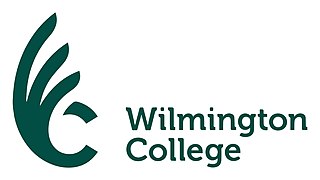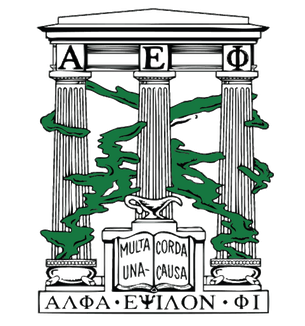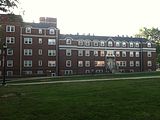
Wilmington College is a private college in Wilmington, Ohio. It was established by the Religious Society of Friends (Quakers) in 1870 and is accredited by the Higher Learning Commission. The college is still Quaker-affiliated and has seven core Quaker values. In fall 2018, the college set an enrollment record, bringing in 450 new students for the academic year, totaling 1,103 students on Wilmington's main campus, and 139 students at Wilmington's two Cincinnati branches at Blue Ash and Cincinnati State.
Dartmouth College is host to many fraternities and sororities, and a significant percentage of the undergraduate student body is active in Greek life. In 2005, the school stated that 1,785 students were members of a fraternity, sorority, or gender-inclusive Greek house, comprising about 43 percent of all students, or about 60 percent of the eligible student body. Greek organizations at Dartmouth provide both social and residential opportunities for students and are the only single-sex residential option on campus. Greek organizations at Dartmouth do not provide dining options, as regular meal service has been banned in Greek houses since 1909.

Iowa Wesleyan University was a private university in Mount Pleasant, Iowa, United States. It was Iowa's first co-educational institution of higher learning and the oldest of its type west of the Mississippi River. The institution was affiliated with the United Methodist Church. It closed at the end of the 2022–23 academic year due to financial challenges.

Fairmont State University is a public university in Fairmont, West Virginia.

The National Panhellenic Conference (NPC) is an umbrella organization for 26 national and international women's sororities throughout the United States and Canada. Panhellenic refers to the group's members being autonomous social Greek-letter societies of college women and alumnae.

Alpha Epsilon Phi is an American sorority and a member of the National Panhellenic Conference. It was the second Jewish sorority formed in the United States.
The North American fraternity and sorority system began with students who wanted to meet secretly, usually for discussions and debates not thought appropriate by the faculty of their schools. Today they are used as social, professional, and honorary groups that promote varied combinations of community service, leadership, and academic achievement.

Alpha Delta Theta (ΑΔΘ) was a national collegiate sorority operating in the United States from 1919 to 1939. The sorority officially affiliated with Phi Mu fraternity on August 30, 1939.

Washington & Jefferson College is host to 8 Greek organizations and a significant percentage of the undergraduate student body is active in Greek life. With 43% of women and 40% of men of the student body participating in "greek life," fraternities and sororities play a significant role in student life at W&J. The Princeton Review named Washington & Jefferson College 12th on their 2010 list of "Major Frat and Sorority Scene" in the United States. As of 2021, the Office of Fraternity & Sorority Life recognized 4 fraternities, Alpha Tau Omega, Beta Theta Pi, Delta Tau Delta, and Phi Kappa Psi, and four sororities, Delta Gamma, Kappa Alpha Theta, Kappa Kappa Gamma, and Pi Beta Phi. The fraternities are governed by a local Interfraternal Council and the sororities are governed by a local Panhellenic Council, while the Greek Judiciary manages broad policy violations at the chapter-level. All Greek organizations occupy College-owned houses on Chestnut Street on campus. All members of fraternities and sororities must pay the $100 "Greek Membership Fee," a levy designed to fund leadership seminars and other educational events for Greeks.

Clemson University opened in 1893 as an all-male military college. It was not until seventy years later in 1959 that the first fraternities and sororities arrived on campus. In the 1970s, they became recognized as national fraternities and sororities. The Greek life has now increased to 44 chapters on campus: fraternities and sororities from the National Panhellenic Conference, the North American Interfraternity Conference, the Multicultural Greek Council, and the National Pan-Hellenic Council.
Beta Sigma Omicron (ΒΣΟ) is a defunct American collegiate sorority. It was founded on December 12, 1888, at the University of Missouri and merged with Zeta Tau Alpha on August 7, 1964.



















